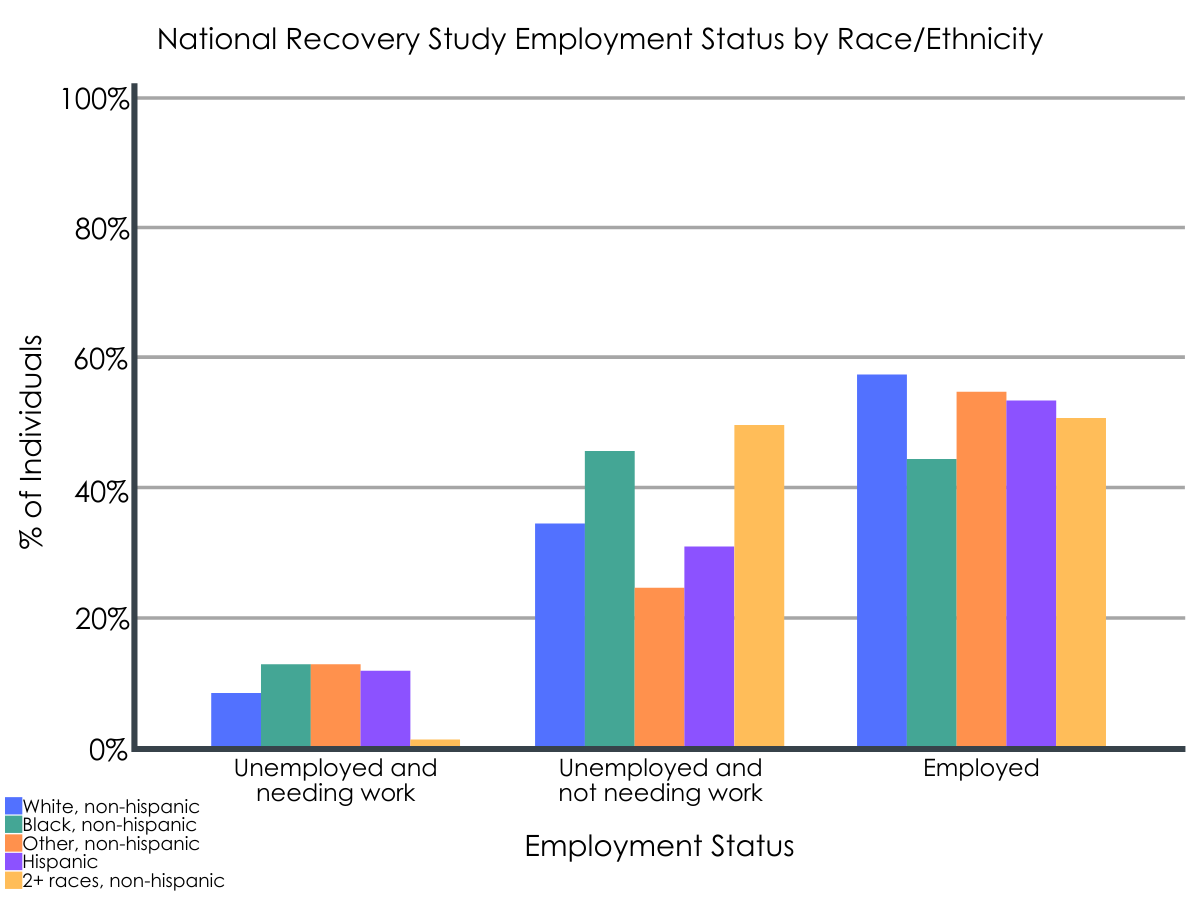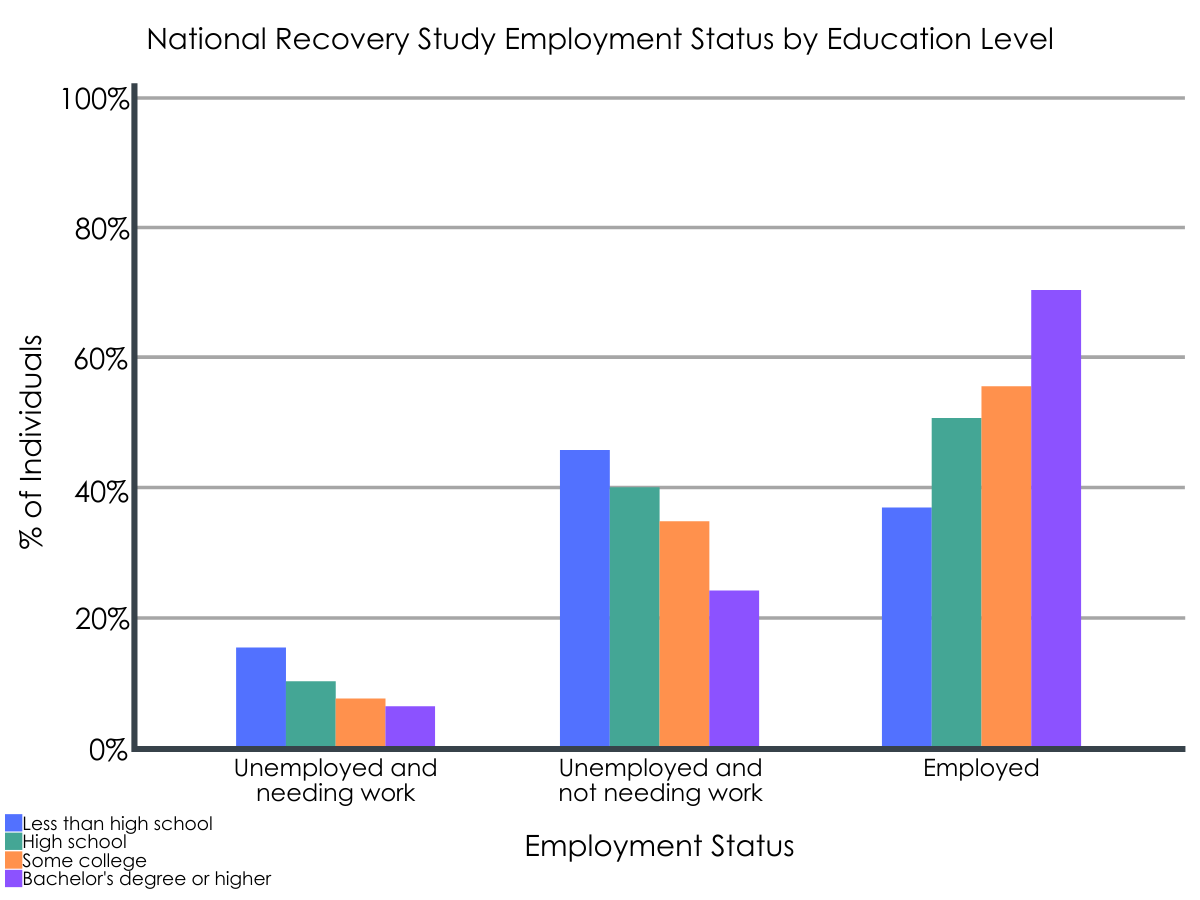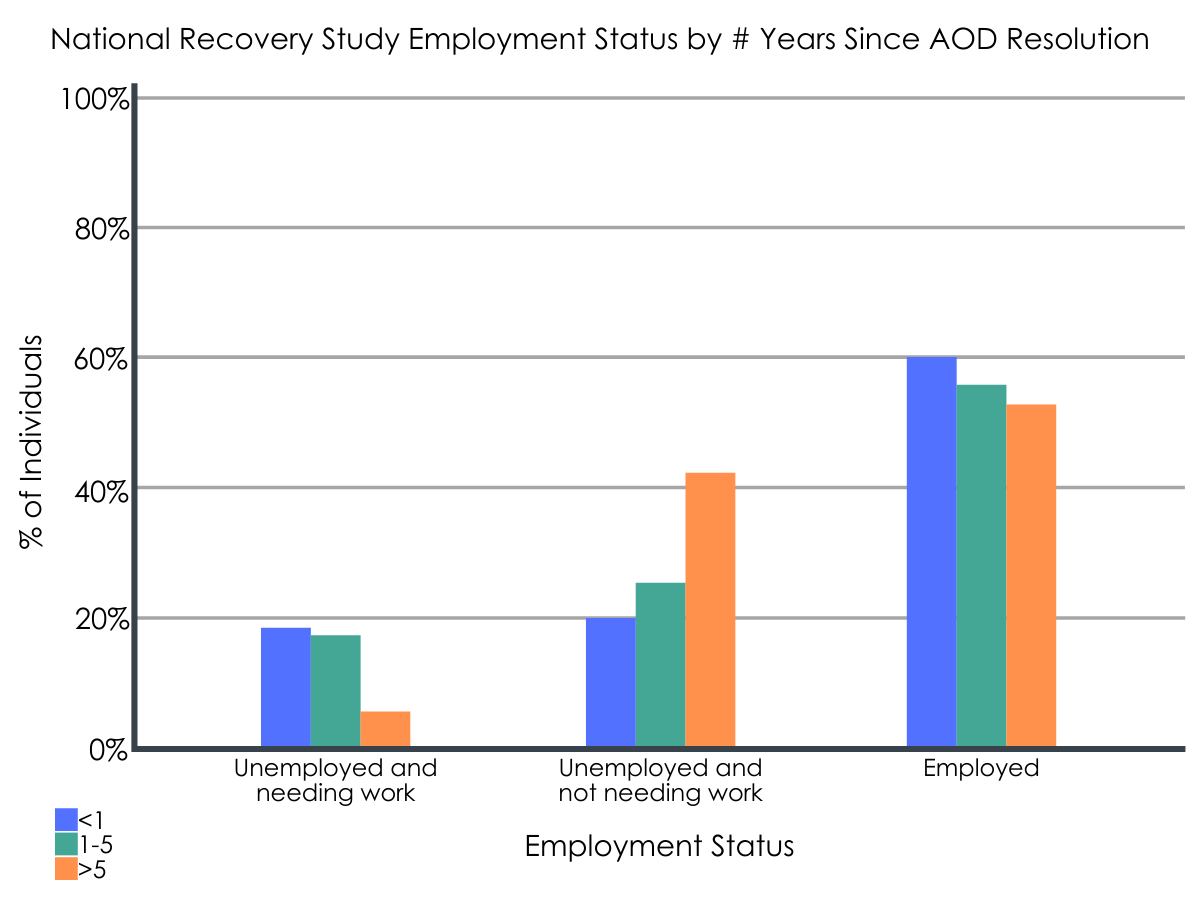Do you work if “you work it”? Employment status in a nationally representative sample of U.S. individuals who have resolved a significant substance problem
Individuals dealing with substance use problems regularly face numerous social and policy-related barriers to returning to work. However, employment can provide critical building blocks for recovery (e.g., access to independent housing and health insurance) and may be protective against relapse by providing structure, meaning, purpose, and income. Despite the important role of employment in substance use disorder (SUD) recovery, little is currently known about employment rates among individuals who have overcome problems with substances, and how employment relates to other aspects of recovery. To inform employment needs for individuals in recovery, researchers examined employment data from a nationally representative sample of U.S. adults who reported having resolved a substance problem while also comparing these data to labor statistics from the general U.S. population.
WHAT PROBLEM DOES THIS STUDY ADDRESS?
SUD and associated problems exact a massive annual economic toll in the U.S., driven largely by lost productivity due to illness-related absenteeism, underemployment (i.e., where employment doesn’t provide sufficient resources to meet basic needs like housing and food), and unemployment. Accordingly, helping individuals who have overcome a substance problem get back to work is economically imperative. Employment can provide essential building blocks for recovery (e.g., access to independent housing and health insurance) and studies have shown employment may be protective against relapse. Yet this population regularly faces limited access to employment resources, and due to the highly stigmatized nature of addiction, they also face numerous social and policy-related barriers to returning to work. These challenges are thought to give rise to marked differences in employment rates from that seen in the general U.S. population; however, this assumption has never been examined empirically. Thus, the authors sought to address this key gap in in current knowledge by describing employment data from a nationally representative sample of U.S. adults who reported having resolved a substance problem and comparing these figures to the labor statistics from the general U.S. population.
HOW WAS THIS STUDY CONDUCTED?
This study used data from the National Recovery Study, a large, nationally representative survey of 2,002 U.S. adults who indicated that they “used to have an alcohol or drug problem, but no longer do”. As part of the survey, participants answered questions regarding demographic characteristics, employment information, primary substance, recovery attempts, criminal justice involvement, clinical histories, and measures of psychological well-being.
In this study, the authors classified participants of the National Recovery Study into employment categories that could be compared to those kept for the general adult U.S. population by the Bureau of Labor Statistics. These categories were 1) employed (i.e., working as a paid employee or self-employed), 2) unemployed and needing work (i.e., on temporary layoff from a job or looking for work), or 3) unemployed but not requiring work (i.e., retired or disabled). The authors then compared National Recovery Study sample to the U.S. population to see if there were systematic differences in employment rates across the two groups and examined if these employment rates varied as a function of race, education and number of years since they resolved their substance problem. Additionally, they went on to establish the relationship between employment in the National Recovery Study, other aspects of recovery, and indicators of well-being after a substance problem was resolved.
As detailed in previous publications from this sample, eligible participants (i.e., endorsed having resolved a significant substance problem) were 44 years old on average, 40% female, and 39% identified as a racial/ethnic minority. At the time of the survey, it had been several years since many individuals resolved their substance problem, with roughly 35% resolving their problem 5-15 years ago, and 29% more than 15 years ago.
WHAT DID THIS STUDY FIND?
Individuals who had resolved a substance problem were less likely to be employed, and more likely to be unemployed and disabled than the general U.S. population.
Compared to the U.S. population, the National Recovery Study sample was significantly more likely to be “not working–on a temporary layoff from a job”, “not working–looking for work”, and “not working–disabled.” They were also less likely to be “working–as a paid employee”, and “not working–retired.”
Those identifying as Black and those with histories of multiple arrests were less likely to be employed, while those with higher levels of education and longer time since problem resolution were more likely to be employed.
Certain individual characteristics were associated with different odds of being employed. Individuals identifying as Black were 50% less likely to be employed compared to those identifying as White. Interestingly, having ever been arrested (yes or no) was not associated with employment status. However, those with more arrests were less likely to be employed, and compared to those with no previous arrests, participants with two or more arrests were 43% less likely to be employed. Meanwhile, after adjusting for age, those with higher levels of education and longer time since problem resolution were more likely to be employed.
Employment status also varied as a function of primary substance used such that individuals indicating amphetamine and cannabis, respectively, as their primary substance, were more likely to be unemployed compared to those reporting alcohol as their primary substance. Importantly, there were no differences in employment status by sex.

Figure 1.

Figure 2.

Figure 3.
Employment was associated with increased quality of life, happiness, and self-esteem.
As expected, those who were employed also reported higher greater quality of life, happiness, and self-esteem when compared to those that reported being unemployed.
WHAT ARE THE IMPLICATIONS OF THE STUDY FINDINGS?
Individuals who are attempting to overcome or have overcome a substance problem face myriad challenges. This study’s findings are the first to report on national employment and unemployment percentages among individuals who report substance problem resolution, and they show significant disparities in comparison to the general U.S. population.
Prevalence of employment when the survey was conducted (July-August 2016) was significantly lower in the National Recovery Study sample (47.7%) than the general U.S. population (56.9%), reflecting an absolute level difference of 9%, but a relative disadvantage of almost 20%, compared to individuals of the same age in the U.S. general population. Given the many challenges that individuals face after overcoming a substance problem, some employment disparities relative to the general U.S. population are expected. However, the magnitude of the differences reported here are cause for concern. Unemployment percentage was significantly better among those with >5 years since problem resolution. This suggests that with more time in recovery, individuals are making strides in their education, legal status, personal lives, etc. which when taken together might offset employment disparities.
Observed differences in employment status appear to be furthered by a series of factors consistent with broader inequities seen in the U.S. Specifically, those that identified as Black (versus White) and as having multiple arrests, respectively, were less likely to be employed. Although a considerable body of evidence shows racial and ethnic minorities bear a disproportional burden of substance-related health, social, and legal consequences despite lower prevalence of SUD, these findings are the first concrete evidence of differences in percentages of employment and unemployment among individuals who identify as Black and having resolved a substance problem. Moreover, this pattern of findings underscores the notion of “intersectionality”, where a person can be a member of several disadvantaged groups simultaneously, making it increasingly difficult to overcome barriers to recovery. Conversely, certain factors, such as more education appear to buffer individuals against unemployment risk. These findings are particularly striking because employment is a means to accrual of essential recovery capital and a major driver of many other positive aspects of individuals’ lives.
- LIMITATIONS
-
- Although the sample was nationally representative, the study design was cross-sectional, and thus any causal inferences should be made cautiously without future longitudinal investigations. Although education was associated with a better odds of employment, for example, the study cannot speak to whether the educational attainment occurred before or after resolving a substance problem.
- The survey methodology relied on participants’ retrospective recall, which could be prone to bias, either over or underestimating recovery attempts.
- Individuals aged 16-17 were included in U.S. population unemployment statistics obtained from the Bureau of Labor Statistics and could not be parsed out when calculating unemployment statistics. This may have subtly affected the accuracy of comparisons with the NRS sample on these specific unemployment measures because the National Recovery Study sampled individuals 18 years or older.
BOTTOM LINE
- For individuals and families seeking recovery: This study showed that, compared to the general U.S. population, individuals who had resolved a substance problem were less likely to be employed or retired and more likely to be unemployed and disabled. Unemployment rates were larger among already marginalized populations, such as those identifying as Black and those with histories of multiple arrests, whereas those with higher levels of education and more time in recovery were less likely to be unemployed. If you are a person in recovery, interested in attempting recovery, or a family member of someone dealing with these issues, this may make the picture look a bit bleak. This is an understandable position given the findings. However, the fact that longer times since problem resolution were associated with better outcomes is cause for optimism. Also, the finding that employment was associated with better quality of life, happiness, and self-esteem means focusing on employment early in recovery appears to confirm the intuitive notion that having a job leads to benefits beyond just dollars and sense. There are several programs designed to help individuals in recovery obtain gainful employment. Here are a few links that might be helpful for those in or around Massachusetts, New Hampshire, West Virginia, and the United Kingdom.
- For treatment professionals and treatment systems: This study showed that, compared to the general U.S. population, individuals who had resolved a substance problem were less likely to be employed or retired and more likely to be unemployed and disabled. Unemployment rates were larger among already marginalized populations, such as those identifying as Black and those with histories of multiple arrests, whereas those with higher levels of education and longer time since problem resolution were less likely to be unemployed. Given that employment is a means to accrue essential recovery capital and a major driver of so many other positive aspects of individuals’ lives, treatment programs and professional need to integrate employment re-entry services into standard care. This wrap-around approach would likely improve the odds of achieving long-term recovery as well as make the early days much easier on those we work with.
- For scientists: This study showed that, compared to the general U.S. population, individuals who had resolved a substance problem were less likely to be employed or retired and more likely to be unemployed and disabled. Unemployment rates were larger among already marginalized populations, such as those identifying as Black and those with histories of multiple arrests, whereas, those with higher levels of education and longer time since problem resolution were less likely to be unemployed. Given that employment is a means to accrue essential recovery capital and a major driver of so many other positive aspects of individuals’ lives, further research should explore more deeply the factors that influence employment among individuals in recovery so that employment disparities may be better addressed and systematic barriers can be overcome. Moreover, this reveals a need to develop and test programs intended to enhance employment among those in early recovery.
- For policy makers: This study showed that, compared to the general U.S. population, individuals who had resolved a substance problem were less likely to be employed or retired and more likely to be unemployed and disabled. Unemployment rates were larger among already marginalized populations, such as those identifying as Black and those with histories of multiple arrests, whereas, those with higher levels of education and longer time since problem resolution were less likely to be unemployed. These results speak to the potential value of systemic and structural changes to improve employment rates and that employment barriers be dismantled for individuals in recovery or attempting recovery. Also, this highlights the potential added value of increasing community resources, such as recovery community centers, that can provide critical support to individuals seeking to re-enter employment.
CITATIONS
Eddie, D., Vilsaint, C. L., Hoffman, L. A., Bergman, B. G., Kelly, J. F., & Hoeppner, B. B. (2020). From working on recovery to working in recovery: Employment status among a nationally representative US sample of individuals who have resolved a significant alcohol or other drug problem. Journal of Substance Abuse Treatment, 113. doi: 10.1016/j.jsat.2020.108000

